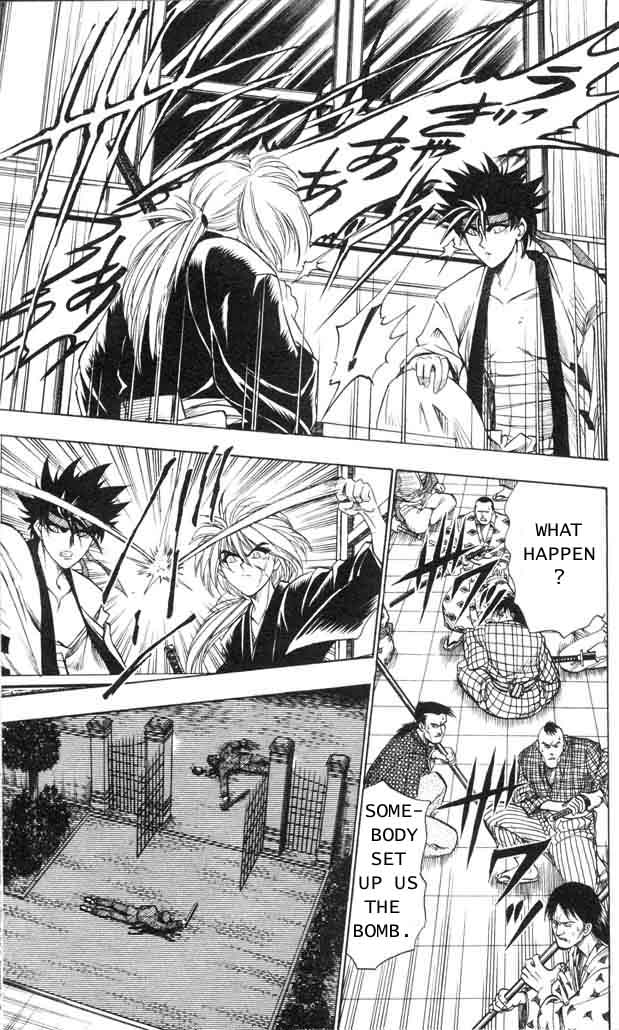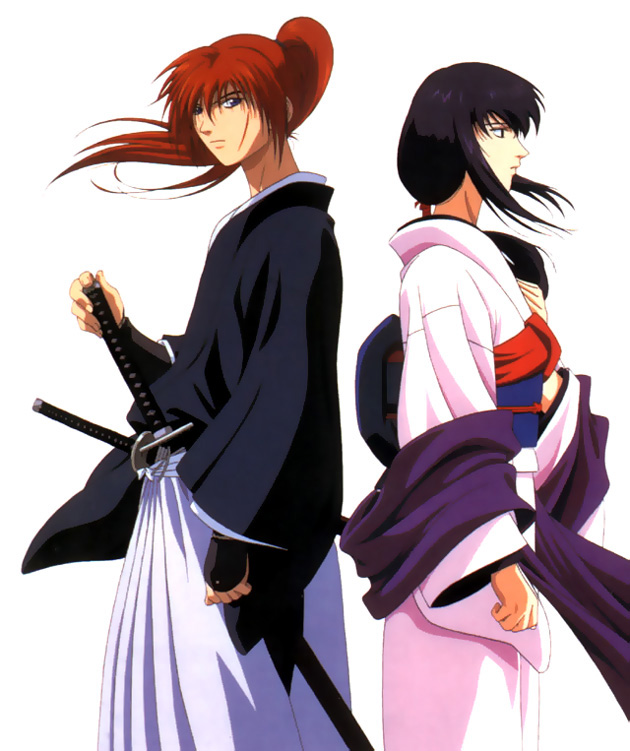
SAMURAI X: THE LEGENDARY SWORDSMAN

るろうに剣心 明治剣客浪漫譚- Rurouni Kenshin: Meiji Swordsman Romantic Story
Samurai X, or better known as Rurouni Kenshin, is a Japanese manga series written and illustrated by Nobuhiro Watsuki. The story is presented fictionally in the historical context of the early Meiji period where a leftover Tokugawa-era assassin named Himura Kenshin becomes a wanderer to protect the people of Japan. Kenshin premiered in Weekly Shōnen Jump in 1994 and was serialized in the magazine until 1999. The 255 individual chapters were collected and published in 28 tankōbon volumes by Shueisha, with the first volume released on September 9, 1994 and the last on November 4, 1999. The series has been adapted into anime, film, OVAs, and plenty of spinoff creations featuring the different characters of Kenshin.




The Media
In a manga volume prior to the release of the anime, Watsuki said that while some fans might object to the adaptation of the series into anime, Watsuki looked forward to the adaptation and felt it would work since the manga was already "anime-esque." Watsuki said that it would be impossible to make the anime and manga exactly the same, so he would feel fine with the anime adaptation as long as it took advantage of the strengths of an anime format.
The anime, directed by Kazuhiro Furuhashi, began airing on Japan's Fuji TV on January 10, 1996 and ended on September 8, 1998. It was produced by Aniplex and Fuji TV, and was animated from episode 1 to 70 by Studio Gallop, whereas the episodes from 70 onwards were animated by Studio Deen. (more on anime...)
The series also has a movie called Samurai X: The Motion Picture which tells a story where a samurai who has a personal vendetta for Kenshin tries to start a revolution by overthrowing the Meiji government. The film was directed by Hatsuki Tsuji and it premiered in Japan on December 20, 1997.
There are also two Rurouni Kenshin original video animation (OVA) series which have respectively four and two episodes. The first of them, Samurai X: Trust & Betrayal, was released in 1999 in Japan and in 2003 was collected into a two hour feature-length motion picture with new animated sequences and released in North America as a Director's Cut DVD. It is set during the downfall of the Tokugawa shogunate and during Kenshin's job as an assassin. The second OVA, Samurai X: Reflections, is set both during and after the timeline of the series and tells of Kenshin and Kaoru's later years, much of which is not derived from the manga.It was later released in the United States by ADV Films in DVD in March 25, 2003, while a Director's Cut edition was later released.

The Story
Rurouni Kenshin takes place during the early Meiji era in Japan and follows the story of a peaceful wanderer named Himura Kenshin, formerly known as the legendary assassin "Hitokiri Battōsai." After participating in the Bakumatsu revolution, Kenshin wanders the countryside of Japan offering protection and aid to those in need as atonement for the murders he once committed as an assassin. When arriving in Tokyo in the 11th year of Meiji (1878), he helps a young woman named Kamiya Kaoru struggling to keep the honorable name of her father's swordsmanship school after a murderer claiming to be the Hitokiri Battōsai tries to kill her. Dispite discovering that Kenshin is the real Battōsai, she finds him a gentle person instead and offers that he live in her dojo. Kenshin accepts and begins to establish lifelong relationships with many people such as Sagara Sanosuke, a former Sekihō Army member; Myōjin Yahiko, an orphan from a samurai family; and a doctor named Takani Megumi. However, he also deals with his fair share of enemies, new and old, including his rival from the Bakumatsu Saitō Hajime and the former leader from the Oniwabanshū, Shinomori Aoshi. Together, they encounter many of the issues caused by the revolution such as hired assassins, kidnappers, rebels, ninjas, and even crimes of the Opium trade.
After living in the dojo for some time, Kenshin discovers that his successor as assassin of the shadows, Shishio Makoto, plans to conquer Japan by destroying the Meiji Government, starting with Kyoto. Feeling that his friends may be attacked by Shishio's faction, Kenshin goes to meet Shishio alone in order to defeat him. However, many of his friends, including a young Oniwabanshū named Makimachi Misao, decide to help him in his fight. He decides to accept their help and defeats Shishio in a fight, who dies in the process due to the rise in body temperature caused by his burns. The anime adapts the manga until this part, later featuring new story arcs which were not featured in the manga.
When Kenshin and his friends return to Tokyo, Kenshin encounters Yukishiro Enishi, who plans to take revenge by killing his friends. At this point it is revealed that, during the Bakumatsu, Kenshin used to be married to a woman called Yukishiro Tomoe, who initially wanted to avenge the death of her fiancé, whom Kenshin had killed, but instead both fell in love and got married. It is then discovered that Tomoe was part of a group of assassins that wanted to kill Kenshin, and Tomoe is betrayed by them and captured to use as bait. Kenshin rushes in to rescue her, killing both his assailant and accidentally Tomoe, who jumps in at the last minute to save Kenshin from a fatal attack. The mystery behind Kenshin's cross-shaped scar is finally unveiled. Wanting to take revenge for the death of his sister, Enishi kidnaps Kaoru and leaves behind a tortured figure bearing a stunning resemblance of the girl for Kenshin to find and momentarily grieve over. Once discovering that Kaoru is alive, Kenshin and his friends set to rescue her. A battle between Kenshin and Enishi follows and when Kenshin wins, he and Kaoru return home. Five years later, Kenshin has found true peace; he is married to Kaoru and has a son named Himura Kenji.



Historical Adaptations
During his childhood, Watsuki used to practice kendo which influenced him in the making from the series. Although, Watsuki developed various one-shots prior to the official serialization from the series, he mentioned he based the series from Crescent Moon in the Warring States, a story which introduced Kenshin's fighting style and his teacher. While naming the characters, he based some of their names from places he used to live such as Makimachi Misao's "Makimachi" and Sanjō Tsubame, who are named after places from Niigata. With the historic concept, Watsuki intended to use the Bakumatsu time period from Moeyo Ken (Burn, O Sword) with a story akin to Sugata Sanshirō. Many of the events are based on reactions to the revolution and transition from the Edo period of the late Tokugawa shogunate to the supposed peaceful era of the Meiji government.
The Tokugawa Era
The Tokugawa (or Edo) period brought 250 years of stability to Japan. The political system evolved into what historians call bakuhan, a combination of the terms bakufu and han (domains) to describe the government and society of the period. In the bakuhan, the shogun had national authority and the daimyo had regional authority. This represented a new unity in the feudal structure, which featured an increasingly large bureaucracy to administer the mixture of centralized and decentralized authorities. The Tokugawa became more powerful during their first century of rule: land redistribution gave them nearly seven million koku, control of the most important cities, and a land assessment system reaping great revenues.
The end of this period is particularly called the Late Tokugawa Shogunate. The cause for the end of this period is controversial but is recounted as the forcing of Japan's opening to the world by Commodore Matthew Perry of the US Navy. Foreign intrusions helped to precipitate a complex political struggle between the bakufu and a coalition of its critics. The continuity of the anti-bakufu movement in the mid-nineteenth century would finally bring down the Tokugawa. A struggle arose in the face of political limitations that the shogun imposed on the entrepreneurial class. The government ideal of an agrarian society failed to square with the reality of commercial distribution and a huge government bureaucracy had evolved, which now stagnated because of its discrepancy with a new and evolving social order. Famines hit hard and unrest led to a substantial peasant uprising against officials and merchants in Osaka in 1837.
During the last years of the bakufu, or bakumatsu, the bakufu took strong measures to try to reassert its dominance, although its involvement with modernization and foreign powers was to make it a target of anti-Western sentiment throughout the country. Remedies came in the form of traditional solutions that sought to reform moral decay rather than address institutional problems. The shogun's advisers pushed for a return to the martial spirit, more restrictions on foreign trade and contacts, suppression of rangaku, censorship of literature, and elimination of "luxury" in the government and samurai class. Others sought the overthrow of the Tokugawa and espoused the political doctrine of sonnō jōi (revere the emperor, expel the barbarians), which called for unity under imperial rule and opposed foreign intrusions.
(more on the Edo Period from Wikipedia)...
The Meiji Era
On February 3, 1867, fifteen-year old Mutsuhito succeeded his father, Emperor Kōmei and a new era of Meiji, meaning "enlightened rule", was proclaimed. The Meiji Restoration of 1868 ended the 265-year-old feudalistic Tokugawa shogunate. The first reform was the promulgation of the Five Charter Oath in 1868, a general statement of the aims of the Meiji leaders to boost morale and win financial support for the new government. Its five provisions consisted of
- Establishment of deliberative assemblies
- Involvement of all classes in carrying out state affairs
- The revocation of sumptuary laws and class restrictions on employment
- Replacement of "evil customs" with the "just laws of nature" and
- An international search for knowledge to strengthen the foundations of imperial rule.
When United States Navy ended Japan's sakoku policy, and thus its isolation, the latter found itself defenseless against military pressures and economic exploitation by the Western powers. For Japan to emerge from the feudal period, it had to avoid the colonial fate of other Asian countries by establishing genuine national independence and equality. Modernization came to Japan easily through adaptaions of Western forms of government, society, and religion. International peace, as well as domestic peace, was the main goal for the new enlightened Meiji Era.
Despite the movements toward imperialism, many citizens found the transition difficult to adapt to. Swordsmen who brought the revolution found themselves homeless and jobless. Swordsmanship had become obselete with the replacement of westeren firearms and anyone found on the streets carrying a sword were automatically persecuted. Too many of the revolutionary leftovers found the restoration they fought for to be a complete sham since the main ideal of the revolution was to find domestic peace for equality and patriotism. For the government, Westernization was key to having a huge and stable economy- talk about corruption in the wealthy masses...
(more on the Meiji Resoration from Wikipedia and PB)...
(Also more history from Japan...)



Comments (0)
You don't have permission to comment on this page.